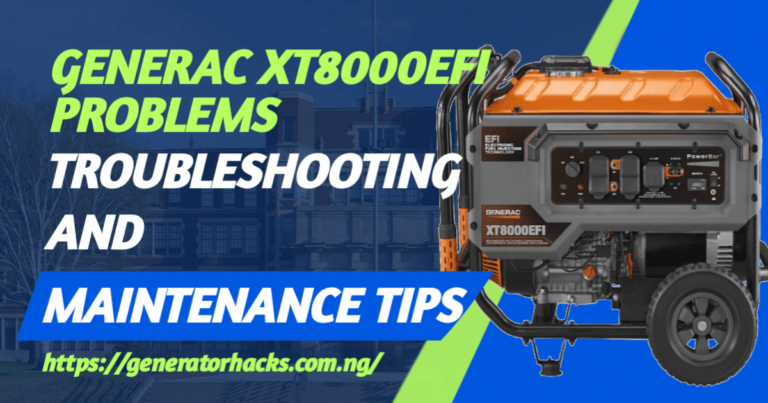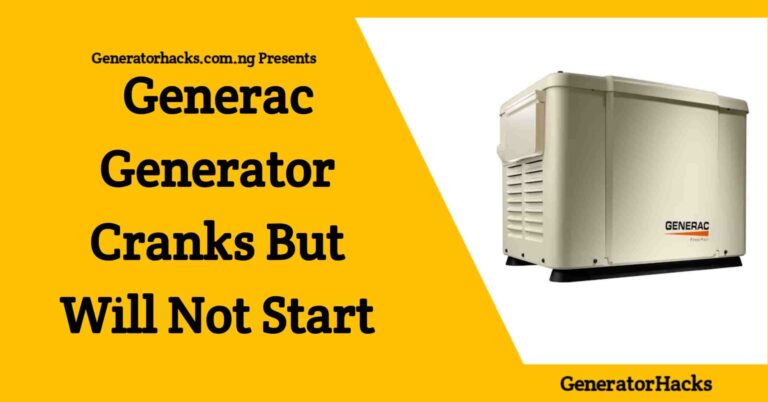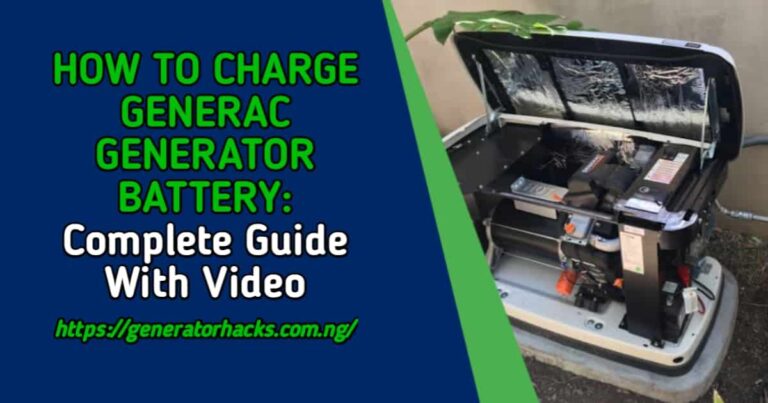As an Amazon Associate, we earn from qualifying purchases. This does not affect the price you pay or the quality of the products you buy. For more information, please read the full affiliate disclosure here.
Picture this: it’s a serene Sunday morning, and you’re sipping a steaming cup of coffee while enjoying the peaceful ambiance of your backyard.
Suddenly, the power flickers, and you instinctively glance toward your Generac generator, expecting it to kick into action and exercise its power-packed muscles.
But wait, something’s not right. Your trusted generator remains dormant, refusing to engage in its regular maintenance routine.
If you find yourself in this frustrating scenario, fear not! In this comprehensive blog post, we will unravel the mysteries behind a Generac generator’s reluctance to exercise.
We’ll guide you through the troubleshooting process, empowering you to restore your generator’s exercise mode and regain your peace of mind.
What You Should Know About Generac Generator Exercise Mode?
Let’s start by clarifying the meaning of the generator exercise. Many standby generators, including Generac models, feature a mode called “exercise mode.”
In exercise mode, the generator runs for a brief period, usually 10 to 15 minutes, each week. This exercise serves multiple purposes, including lubricating engine components, charging the battery, and ensuring the generator is prepared for operation when needed.
The primary objective of the generator exercise is to lubricate the engine parts. When a generator remains idle for extended periods, the lubricating oil can settle, causing parts to dry out and potentially leading to friction and damage.
Regularly running the generator ensures that the oil is circulated throughout the engine, effectively lubricating all components. This preventive measure helps to prevent wear and tear, ensuring the generator’s longevity.
Standby generators like your Generac generator rely on a battery to start the engine during a power outage. However, if the generator remains inactive for extended periods, the battery gradually loses its charge.
By running the generator in exercise mode, the battery can recharge, ensuring it remains ready to provide the necessary power when called upon.
In addition, exercise mode serves as a diagnostic tool for the generator. While operating briefly, the generator’s control panel monitors various parameters and performs self-tests to identify any potential issues or malfunctions.
Prompt detection and resolution of problems prevent further complications or unexpected failures during an actual power outage.
This routine maintenance ensures that the generator remains reliable and ready to supply power when required, providing you with peace of mind during unexpected outages.
Importance of Regularly Generac Generator Exercising
1. Prevention of Engine Damage
Extended periods of inactivity can take a toll on a generator’s engine. When a generator sits idle for too long, the lubricating oil settles, leaving critical engine components susceptible to dryness and friction.
This can lead to damage and hinder the generator’s ability to function optimally when it’s needed the most.
Regular exercise prevents this issue by circulating the lubricating oil throughout the engine, ensuring that all parts receive the necessary lubrication to operate smoothly.
2. Battery Health and Performance
The battery of your Generac generator plays a crucial role in its operation. It provides the initial power required to start the generator’s engine during a power outage.
However, batteries can lose their charge over time, especially when they are not regularly used. Regular exercise mode helps to counteract this by periodically running the generator and recharging the battery.
By keeping the battery fully charged, you ensure that it is always ready to deliver the necessary power when an outage occurs.
This helps maintain the generator’s reliability and ensures that it can start promptly when you need it most.
Also Read:- Generac Generator Not Charging Battery: Troubleshooting Guide
3. Early Issue Detection and Prevention
A generator’s exercise mode also serves as a diagnostic tool. During the exercise cycle, the generator’s control panel monitors various parameters and performs self-tests to identify any potential issues or malfunctions.
By running these checks regularly, the generator can detect problems at an early stage, even before they become noticeable during a power outage.
This allows you to address any emerging issues promptly, preventing them from escalating into more significant problems.
By proactively maintaining your generator, you increase its reliability and reduce the chances of unexpected failures when you rely on it the most.
4. Reliable Performance During Power Outages
Ultimately, the primary purpose of a standby generator is to provide a reliable power source during outages.
Regular exercise ensures that your Generac generator remains in top condition and is ready to perform when needed.
By incorporating exercise mode into your generator’s routine, you enhance its reliability and increase your confidence in its ability to seamlessly kick into action during an emergency.
Causes of Generator Generator Not Exercising
1. Faulty Exercise Timer
The exercise timer is responsible for initiating the exercise cycle on your Generac generator.
If the timer malfunctions or loses power, it can prevent the generator from exercising as scheduled.
This issue can occur due to a faulty timer component or issues with the electrical connections powering the timer.
Also Read:- Generac Generator Weekly Test Not Working? Here’s the Best Ways to Make it Work
2. Battery Issues
A weak or faulty battery can hinder the generator from starting and, consequently, prevent it from entering exercise mode.
If the battery does not have sufficient power, the generator may not be able to initiate the exercise cycle.
This problem can arise due to a battery nearing the end of its lifespan, loose battery connections, or a faulty battery charger.
3. Fuel Problems
Issues related to fuel supply can also cause exercise failure on Generac generators.
If the generator is running low on fuel, it may not have enough fuel to start and run during the exercise cycle.
Similarly, if the fuel supply is contaminated or stale, it can affect the generator’s performance and prevent it from exercising.
4. Wiring and Connection Problems
Problems with wiring and connections can disrupt the exercise routine of your Generac generator.
Loose or damaged wires, faulty connections, or issues with the control panel can prevent the generator from receiving the necessary signals to start the exercise cycle.
Additionally, faulty wiring or connections can cause power loss to the exercise timer or other essential components, resulting in exercise failure.
5. Sensor Trouble
Generac generators are equipped with various sensors that monitor crucial functions such as temperature, oil pressure, and voltage.
If one of these sensors malfunctions, it can prevent the generator from entering the exercise mode.
For example, if a temperature sensor is faulty and incorrectly indicates an overheating condition, the generator may not start the exercise cycle to avoid potential damage.
How to Troubleshoot a Generac Generator Not Exercising
1. Check the Exercise Timer
Start by examining the exercise timer settings. Ensure that the timer is properly programmed and set to initiate the exercise cycle at the desired time.
If the timer appears to be functioning correctly, check its power source.
Ensure that it is receiving power and that no loose connections or electrical issues are affecting its operation.
If necessary, reset or replace the exercise timer to eliminate any faults in this component.
2. Inspect the Battery
Next, focus on the battery, as one of the vital components for the generator’s operation.
Check the battery voltage using a multimeter to ensure it is within the recommended range. If the voltage is low, the battery may be weak or nearing the end of its lifespan.
In such cases, it’s advisable to replace the battery with a new one. Additionally, inspect the battery connections and clean any corrosion or tighten loose terminals to ensure proper electrical contact.
3. Verify Fuel Level and Quality
Check the fuel level in the generator’s tank to ensure it is adequate for the exercise cycle. Low fuel levels can prevent the generator from starting and entering the exercise mode.
Additionally, check the fuel quality. Stale or contaminated fuel can affect the generator’s performance and lead to exercise failure.
If necessary, refill the tank with fresh, clean fuel, and consider adding a fuel stabilizer to prevent fuel degradation over time.
4. Examine Wiring and Connections
Inspect all the wiring and connections associated with the generator, paying particular attention to the control panel, exercise timer, battery connections, and starter circuit.
Look for any loose or damaged wires, frayed insulation, or faulty connectors. Repair or replace any faulty components, ensuring proper electrical connections throughout the generator’s system.
Carefully follow the manufacturer’s guidelines and wiring diagrams to ensure correct reassembly.
5. Consult the Owner’s Manual
Refer to the owner’s manual provided by Generac specific to your generator model.
The manual contains valuable troubleshooting information, diagrams, and instructions tailored to your generator’s specifications.
It will guide you through specific troubleshooting steps and provide insights into potential issues and their solutions.
Familiarize yourself with the troubleshooting section of the manual and follow the recommended steps provided.
6. Seek Professional Help
If you have followed the troubleshooting steps above and the exercise failure issue persists, it may be necessary to seek professional assistance.
Certified Generac technicians have the expertise and specialized tools to diagnose and resolve complex generator issues effectively.
Contacting a professional ensures that the problem is addressed accurately and minimizes the risk of causing further damage to your generator.
Final Thought
Exercise failure on Generac generators can stem from a variety of causes, including faulty exercise timers, battery issues, fuel problems, wiring and connection problems, and sensor troubles.
Identifying the specific cause of exercise failure is key to effectively troubleshooting and resolving the issue.
By addressing these common causes promptly, you can ensure that your Generac generator exercises as scheduled, maintaining its performance and readiness during power outages.
Other Articles You May Enjoy!
🔌 Generator Tools & Social Hub
Maximize your generator knowledge! Use our calculators and join our community for expert tips:
Stay connected for updates and exclusive content:
📘 Facebook Page 🐦 X (Twitter) 📌 Pinterest 🔒 Private Facebook GroupDiscover more from Generator Hacks
Subscribe to get the latest posts sent to your email.








